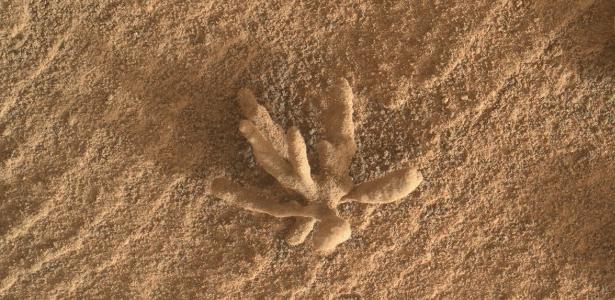
NASA’s robotic rover Curiosity orbiting Mars took a curious picture of the surface of the Red Planet. The image appears to be of a small flower. Project scientists named the novelty “Blackthorn Salt”.
Apparently, the material photographed is composed of mineral formations precipitated in water. To take images very close up, the team of researchers used sensors Mars Hand Lens Imager (MAHLI) of space exploration robots.
It looks like a flower but it’s not
The type of mineral structure identified in the image is formed by clusters of three-dimensional crystals. Since Mars currently has no water in its soil, a flower like Earth is unlikely to be found.
On Twitter, Abigail Freeman, one of the Curiosity mission scientists, commented on the element being photographed: “We’ve seen structures like this before, especially the Pahrump Hills. There, the features were made of salts, called sulfates. Goes.”
According to NASA, Pahrump Hills is an outcrop at the base of Mount Sharp.The mountain in the center of Gale Crater on Mars.
As a result of earlier studies on this type of component on Mars, it was concluded that the resources were “glued” into a rock that, over time, suffered an erosion process. However, the mineral clusters did not erode.
In this way the flower-shaped structure remained.
In 2013, Curiosity found other material that looked like a flower, and the Spirit rover discovered rocks with a similar appearance, which earned the nickname “cauliflower” due to the appearance formed from misshapen projections.
In June 2004, in a study published in the scientific journal Nature, The Opportunity rover found structures similar to Curiosity images, also known as concretions. They earned the nickname “blueberry” because of their small, round shape.
In the image, you can see the rounded right angles in the “object” that looks like a flower.
According to Brazilian researcher Alexandre Zabot, PhD in astrophysics and professor of aerospace engineering course at UFSC (Federal University of Santa Catarina), the structure recorded by the NASA robot is further evidence of the action of erosion by water in the soil. Martian.
“And it’s interesting that it has resisted to this day, because the water on Mars has been gone for a few million years,” he says.
Zabot also points out that, from the moment Mars soils began to be photographed, many geological formations similar to those of planet Earth were found.
“We’re sure we’ll find other structures like this, this is no exception. It’s close to being the rule in things we’re looking for on Mars”, he concluded.
How was the registration done
In general, in images made by the MAHLI sensor of Martian soil, minerals and textures on rock surfaces are revealed due to a close-up camera shot of the photographed element.
The rig’s camera, in turn, is a hand-held magnifying glass version of the Curiosity rover – a technique commonly used by geologists in the field.
*With information from NASA, Science Alerts and Universe Today



